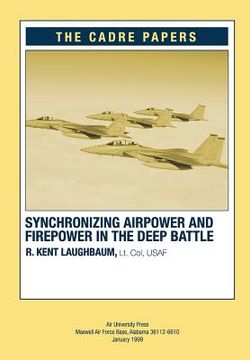Compartir
Synchronizing Airpower and Firepower in the Deep Battle: CADRE Paper (en Inglés)
Lt Col Usaf R. Kent Laughbaum
(Autor)
·
Air University Press
(Contribuciones de)
·
Createspace Independent Publishing Platform
· Tapa Blanda
Synchronizing Airpower and Firepower in the Deep Battle: CADRE Paper (en Inglés) - Press, Air University ; Laughbaum, Lt Col Usaf R. Kent
21,60 €
24,00 €
Ahorras: 2,40 €
Elige la lista en la que quieres agregar tu producto o crea una nueva lista
✓ Producto agregado correctamente a la lista de deseos.
Ir a Mis Listas
Origen: Estados Unidos
(Costos de importación incluídos en el precio)
Se enviará desde nuestra bodega entre el
Miércoles 31 de Julio y el
Miércoles 14 de Agosto.
Lo recibirás en cualquier lugar de España entre 1 y 5 días hábiles luego del envío.
Reseña del libro "Synchronizing Airpower and Firepower in the Deep Battle: CADRE Paper (en Inglés)"
The concept of "deep battle" was formally introduced to US war fighters during the early 1980s through the US Army's AirLand Battle doctrine. As envisioned by Air Force and Army leaders, the initial purpose for the deep battle was to delay and weaken Soviet second and follow-on echelons during a European conventional war. Within the AirLand Battle construct, the Air Force had responsibility for synchronizing deep operations and for employing air interdiction against Soviet maneuver forces to set the conditions for victory in the decisive "close battle." The fire support coordination line (FSCL), normally positioned at field artillery maximum range from the forward line of troops (FLOT), separated the Air Force's deep operations from the Army's close battle. During the late 1980s the Army began fielding a potent deep-battle capability of its own. Concurrently, Army doctrine assigned to the ground force commander responsibility for synchronizing deep operations with the close battle. Thus were planted the seeds of conflict with the Air Force over management of the deep battle. To better influence deep operations, the Army defined the FSCL as a permissive fire support coordination measure and also extended the range of the FSCL from the FLOT. The Persian Gulf War "field tested" US deep-battle doctrine. The joint force air component commander (JFACC) synchronized deep operations using several ad hoc procedures approved the joint force commander (JFC). By most Air Force accounts, the deep battle was well managed and executed, except for the Army's use of the FSCL during the last days of the war. Conversely, the Army was thoroughly disappointed with prosecution of the deep battle during Operation Desert Storm. Army frustration arose from the fact that the deep battle was synchronized by the JFACC and not by the ground force commander - a direct violation of joint and Army doctrine. Joint doctrine produce since the Gulf War has attempted to create a framework for synchronizing airpower and land-based firepower in the deep battle. In spite of that effort, many contentious issues between airmen and soldiers remain unresolved, chief among them the matter of command relationships on and above the deep battlefield. In this award-winning study on "Synchronizing Airpower and Firepower in the Deep Battle," Lt. Col. R. Kent Laughbaum argues that current joint doctrine does not provide sufficient and acceptable guidance for synchronizing Air Force and Army deep operations. To improve such synchronization, Colonel Laughbaum proposes five modifications to current joint doctrine: assign the joint force commander responsibility for establishing and positioning the fire support coordination line; redefine the fire support coordination line as a restrictive fire support coordination measure; include all planned airpower, firepower, and maneuver operations beyond the fire support coordination line in the air tasking order; position the fire support coordination line relatively close to the forward line of own troops, typically no farther than the maximum range of tube artillery; and restrict planned air interdiction missions from targets short of the fire support coordination line.
- 0% (0)
- 0% (0)
- 0% (0)
- 0% (0)
- 0% (0)
Todos los libros de nuestro catálogo son Originales.
El libro está escrito en Inglés.
La encuadernación de esta edición es Tapa Blanda.
✓ Producto agregado correctamente al carro, Ir a Pagar.

